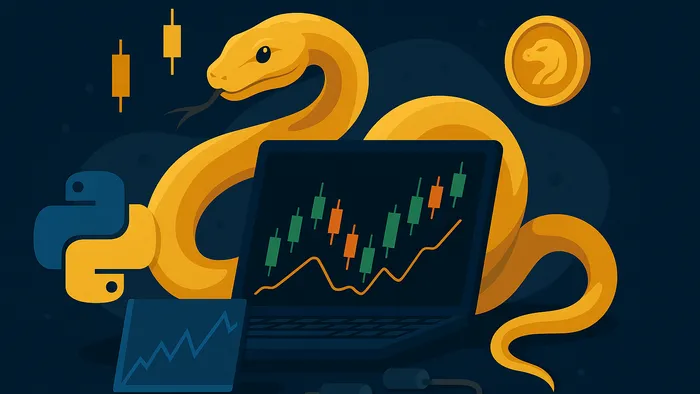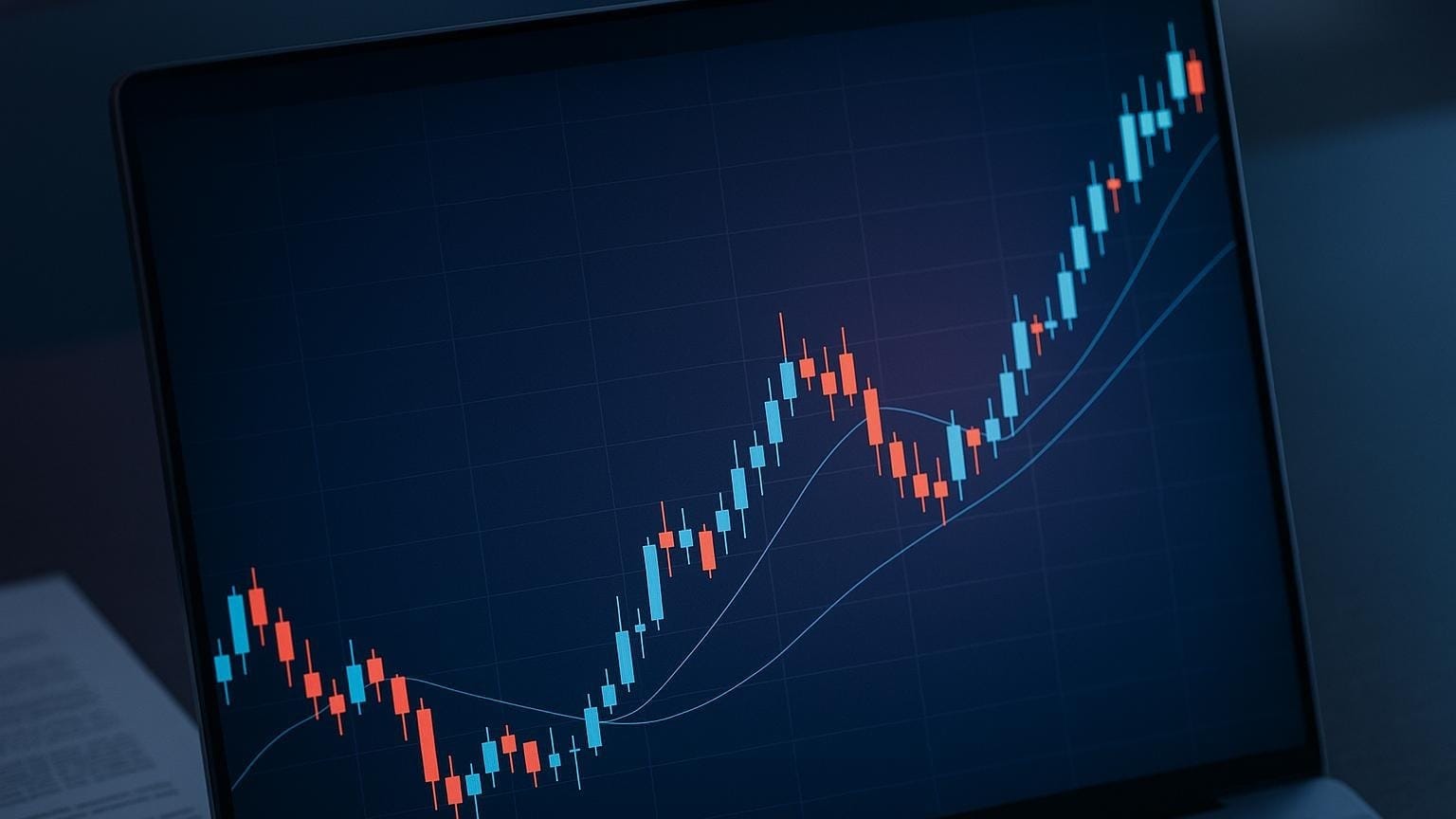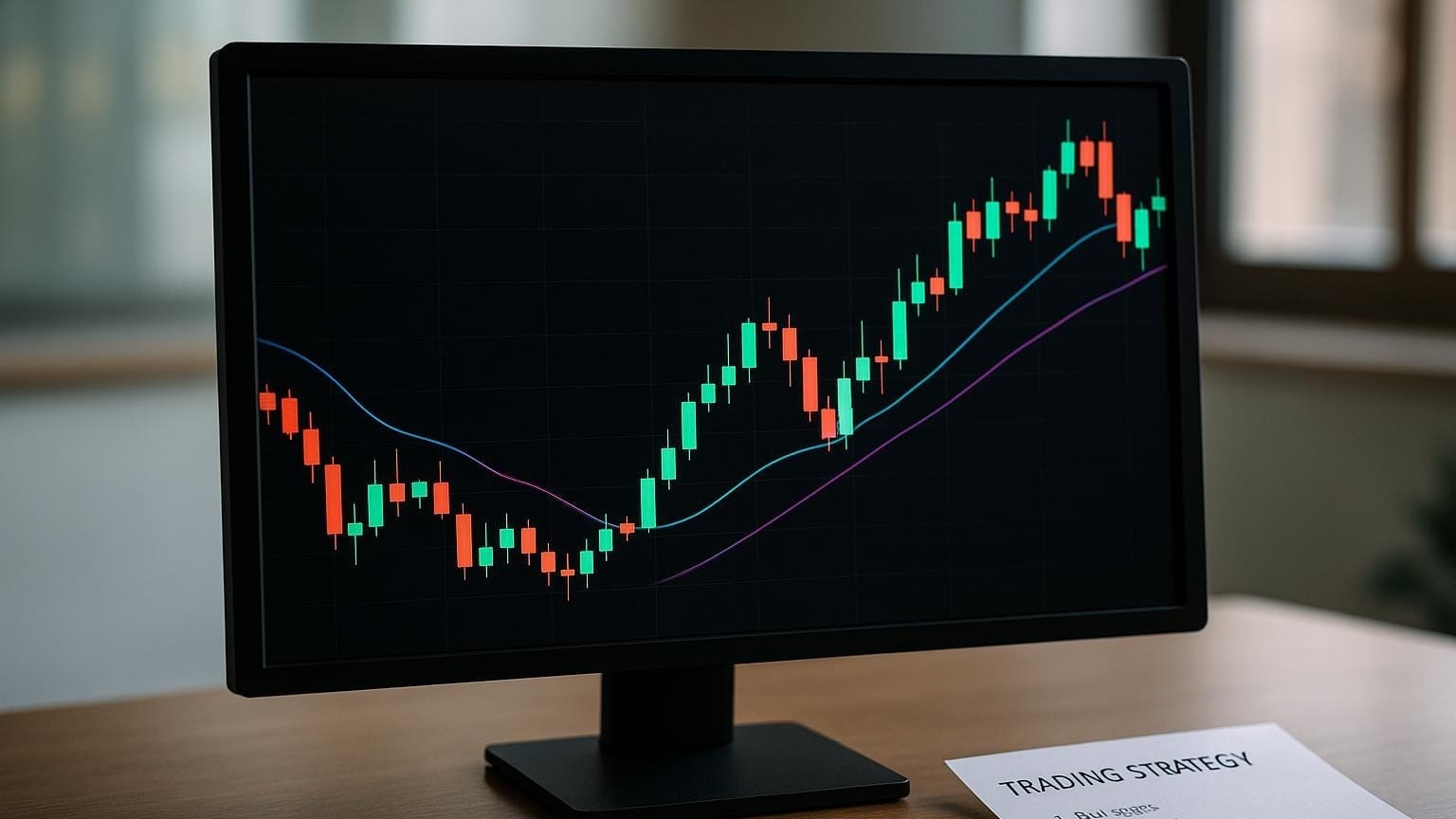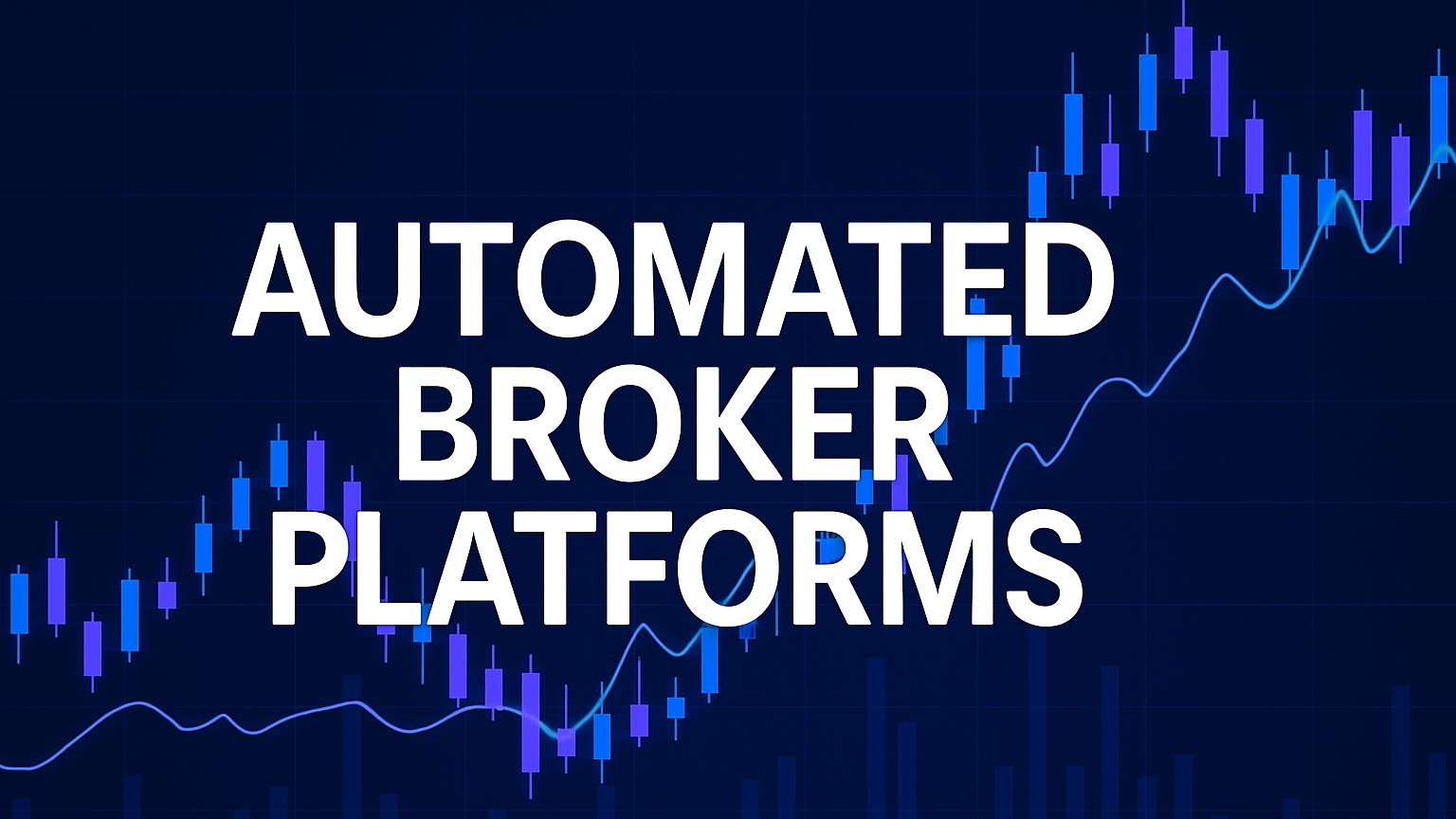Explore essential Python libraries for algorithmic trading, including data processing, technical analysis, strategy testing, and visualization tools.
Algorithmic trading dominates financial markets with 92% of Forex trading automated by 2025. Python is the preferred language for building trading systems due to its simplicity and extensive libraries. Here's what you need to know:
- Key Libraries:
- Data Processing: Pandas, NumPy for analyzing and managing market data.
- Technical Analysis: TA-Lib for indicators like SMA, RSI, and Bollinger Bands.
- Backtesting: Backtrader, Zipline to test and refine strategies.
- Visualization: Matplotlib, Plotly for static and interactive charts.
- Machine Learning: Scikit-learn, TensorFlow for predictive models.
- Why Python?
- Open-source flexibility, simple syntax, and tools for backtesting, live trading, and visualization.
- Quick Start:
- Install Pandas and NumPy to process data.
- Use TA-Lib for generating technical indicators.
- Test strategies with Backtrader or Zipline.
- Visualize results using Matplotlib or Plotly.
Python simplifies the development of trading systems, from data analysis to advanced AI-driven strategies. Dive into the tools above to start building your system today.
TA-Lib Python Tutorial: Installation and Implementation Guide

Data Processing Tools
Data processing is a key part of any algorithmic trading system. Two Python libraries, Pandas and NumPy, are indispensable for handling structured data and performing numerical calculations.
Working with Pandas
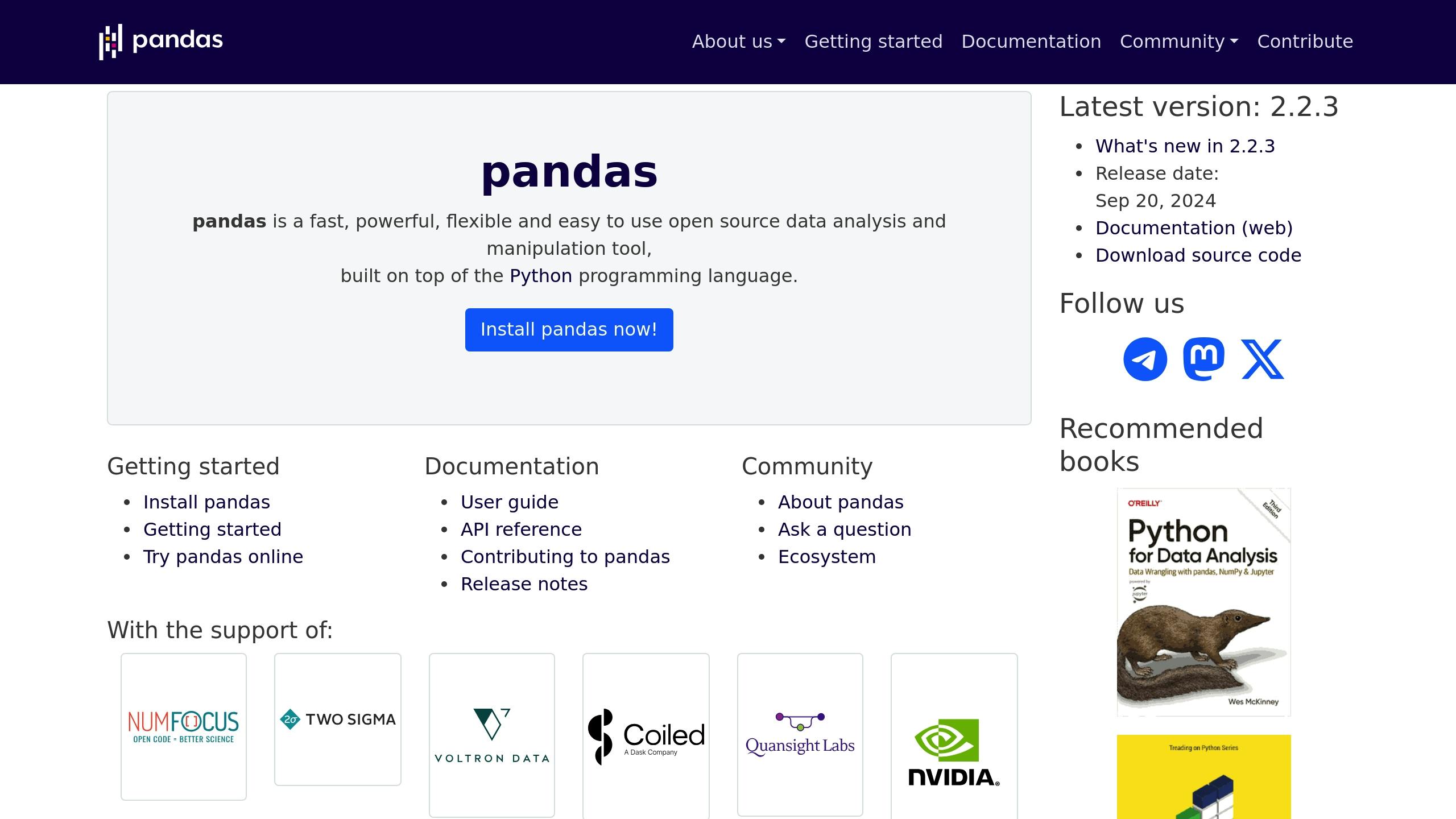
Developed by Wes McKinney in 2008, Pandas has become a go-to library for financial data analysis in Python. Its DataFrame structure makes it easy to work with time-series market data, simplifying tasks like merging, reshaping, and cleaning.
For example, in 2023, traders used Pandas to analyze NVIDIA (NVDA) historical data from Yahoo Finance. They computed 20-day and 50-day moving averages, volatility, and percentile rankings—all with just a few lines of code.
To make the most of Pandas when working with market data, follow these tips:
- Efficient Data Loading: Use memory optimization settings and define data types upfront.
- Data Type Conversion: Opt for smaller integer and float types for price and volume data to save memory.
- Chunk Processing: When reading large files, use the
chunksizeparameter inpd.read_csv()to process data in manageable pieces. - Vectorized Operations: Replace lambda functions in
applywith vectorized alternatives for better performance.
While Pandas is excellent for structuring market data, NumPy steps in to handle the heavy lifting for numerical computations.
NumPy for Calculations
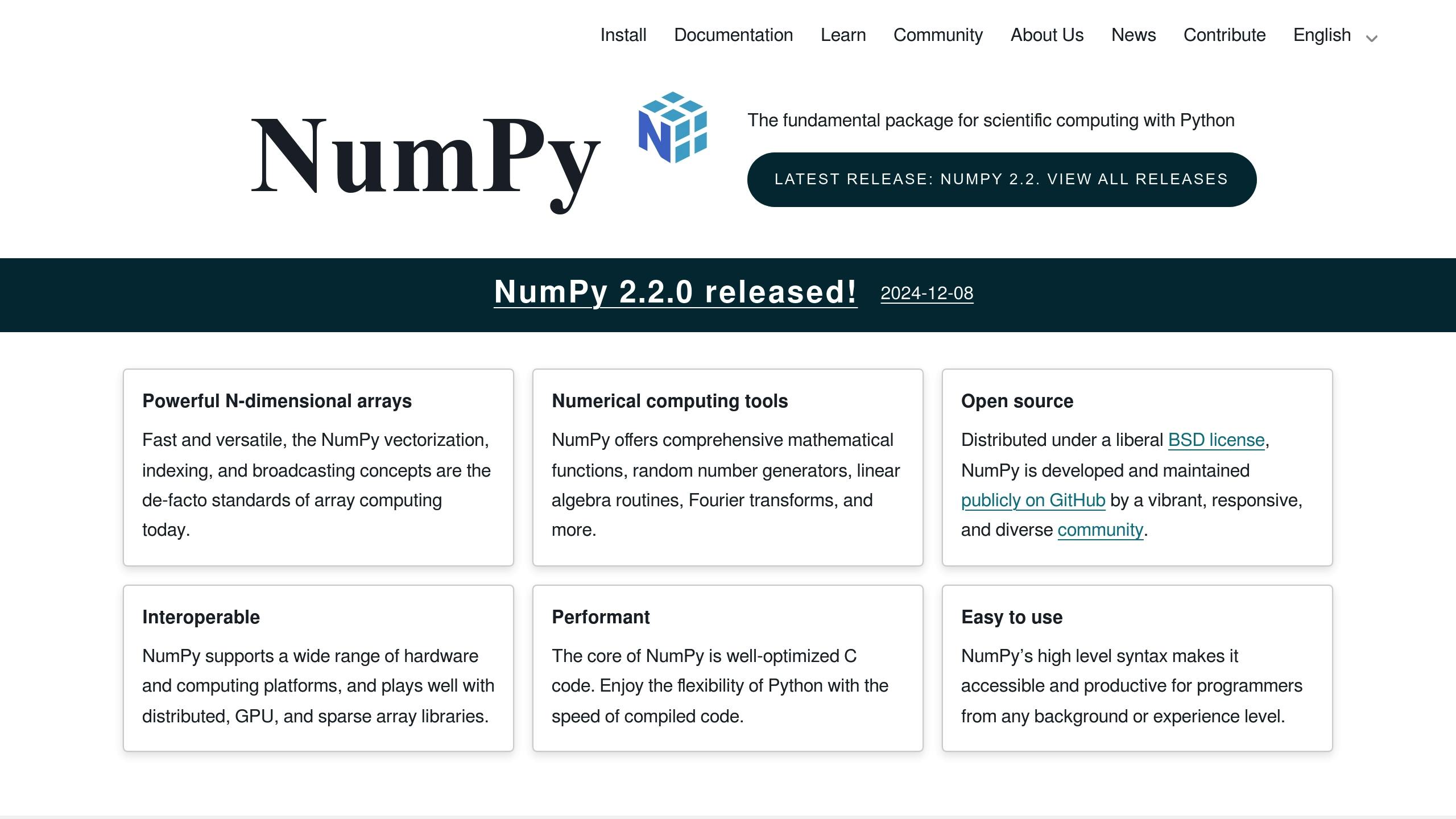
NumPy is known for its speed—its array operations can be up to 20 × faster than standard Python lists. This makes it a powerful tool for trading-related calculations.
Here are some ways NumPy can enhance your workflow:
- Array Operations: Use NumPy arrays for fast calculations on technical indicators.
- Memory Efficiency: For high-frequency trading, NumPy arrays require significantly less memory compared to Pandas structures.
- Performance Optimization: Speed up workflows by pre-allocating arrays with
np.empty(), monitoring memory usage withnbytes, using memory mapping for large datasets, and processing data in chunks.
For datasets up to 2–3 GB, Pandas alone is often enough. However, when working with high-frequency data or performing complex calculations, combining Pandas with NumPy can yield the best results.
Market Analysis Tools
Once you've set up data processing with Pandas and NumPy, it's time to explore tools that can handle technical and statistical market analysis. Two standout options are TA-Lib for technical indicators and Statsmodels for statistical analysis.
TA-Lib Functions
TA-Lib is a popular choice for calculating technical indicators in algorithmic trading systems. With over 150 built-in indicators, it saves development time and ensures precise calculations.
"TA-Lib is a Python library which makes it easy to compute, manage, and use technical indicators." – Rahul Chowdhury
Its C-based backend delivers high-speed performance, making it ideal for real-time trading systems. Here's a quick breakdown of common indicator types and their applications:
| Indicator Type | Common Use Cases | Performance Impact |
|---|---|---|
| Trend | SMA, EMA, MACD | Minimal memory overhead |
| Momentum | RSI, Stochastic | Handles large datasets well |
| Volatility | Bollinger Bands | Optimized for parallel tasks |
Implementation Tips:
- Optimize Data Structure: Use NumPy arrays for price data before feeding it into TA-Lib.
- Memory Management: Pre-allocate arrays for storing results.
- Error Handling: Validate input data to avoid calculation issues.
While TA-Lib focuses on technical indicators, you may need more advanced tools for statistical analysis.
Statistical Analysis with Statsmodels
Statsmodels complements TA-Lib by offering advanced statistical tools for analyzing market trends and testing strategies. This library is particularly useful for tasks like:
- Breaking down time-series data to uncover market cycles.
- Using ARIMA models for price forecasting.
- Testing and validating trading strategies statistically.
- Analyzing correlations between different assets.
Here's how TA-Lib and Statsmodels compare:
| Analysis Type | TA-Lib | Statsmodels |
|---|---|---|
| Speed | Very fast (C backend) | Moderate |
| Statistical Depth | Basic | Advanced |
| Memory Usage | Efficient | Higher |
| Use Case | Real-time indicators | Strategy validation |
While TA-Lib offers speed and efficiency for real-time tasks, Statsmodels dives deeper into statistical insights, making it essential for strategy development and risk assessment. Together, these tools provide a comprehensive framework for market analysis, building on the data processing methods discussed earlier.
Testing Trading Strategies
Before going live, it's crucial to thoroughly test your trading strategies. This step uses the data analysis and handling techniques discussed earlier to ensure your strategies are sound and reliable.
Using Backtrader

Backtrader is a flexible framework for developing and testing trading strategies with minimal setup requirements. Its structure allows you to focus on the strategy itself rather than the technical setup.
| Feature | What It Offers | How to Use It |
|---|---|---|
| Built-in Indicators | Over 122 technical indicators | Quickly apply common trading signals |
| Parameter Optimization | Automated testing of parameter combinations | Fine-tune strategy settings |
| Performance Analytics | Metrics like Sharpe Ratio and Drawdown | Assess and compare strategy performance |
To test strategies effectively with Backtrader:
- Divide historical data into in-sample and out-of-sample sets.
- Factor in transaction costs and test across multiple assets.
- Leverage built-in performance metrics for evaluation.
Testing with Zipline

Zipline uses an event-driven framework to test trading strategies. Its integration with the PyData ecosystem makes it ideal for detailed and complex analyses.
| Function | What It Does | Key Points |
|---|---|---|
initialize(context) |
Sets up the strategy and defines parameters | Configure portfolio settings upfront |
handle_data(context, data) |
Processes market events and executes trades | Avoid look-ahead bias |
Zipline accounts for transaction costs, slippage, and order delays, while working seamlessly with tools like Pandas and Scikit-learn.
As with any testing, careful data handling is essential. Use multiple data sources to ensure accuracy and reliability.
Data Visualization
Data visualization plays a key role in identifying trading patterns and trends, connecting data analysis to actionable trading insights. Python offers several libraries that excel in financial data visualization, each tailored for specific needs.
Charts with Matplotlib
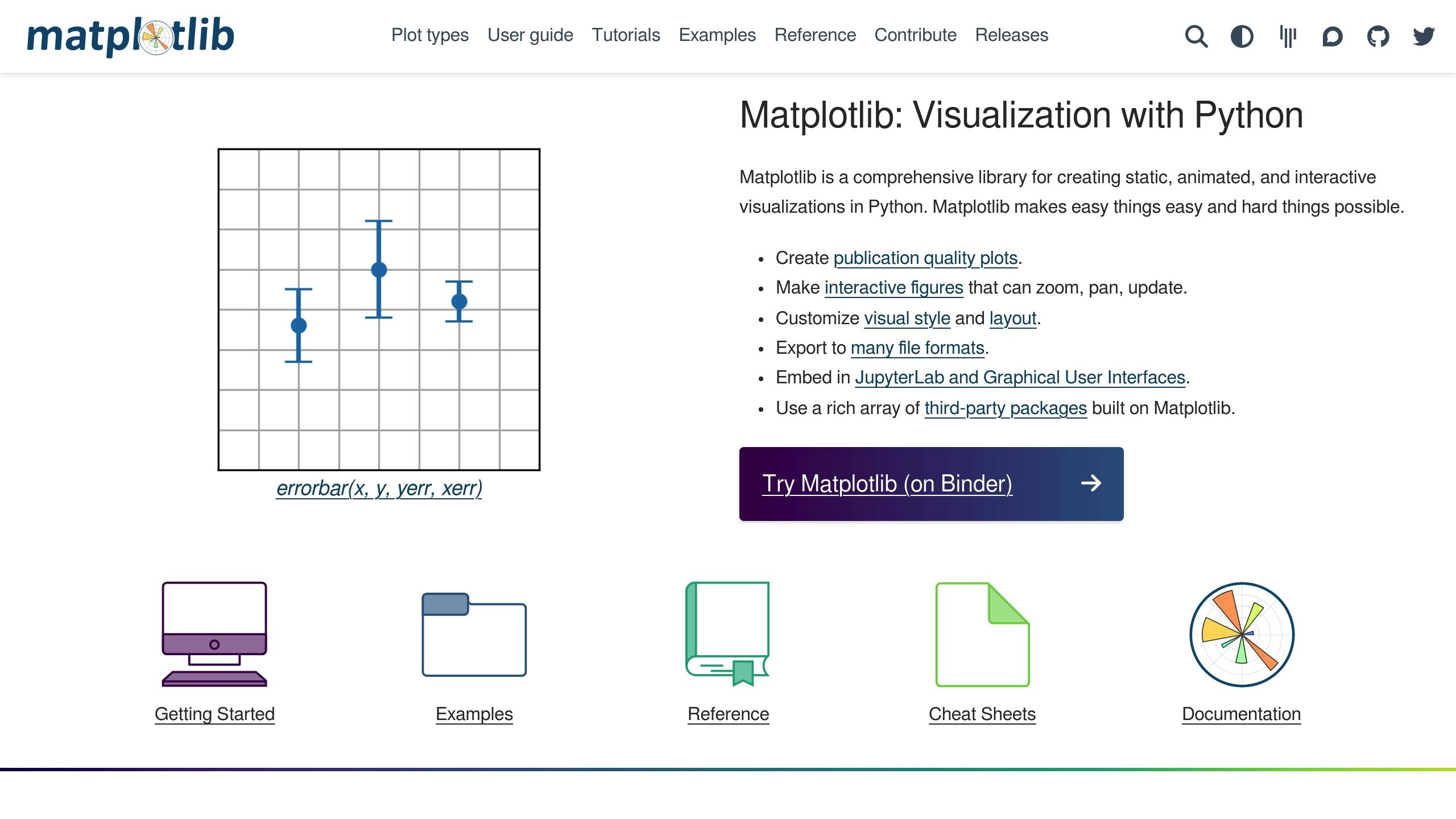
Matplotlib is a core Python library for creating detailed trading charts. It works seamlessly with tools like NumPy and Pandas.
| Feature | Trading Application | Purpose |
|---|---|---|
| Candlestick Charts | Technical Analysis | Displays precise price movement |
| Volume Plots | Volume Analysis | Provides insights into market activity |
| Moving Averages | Trend Analysis | Helps identify market trends |
| Custom Indicators | Strategy Development | Supports proprietary indicators |
For example, traders used Matplotlib to chart Apple’s performance during 2020–2021, uncovering trend patterns as the company rebounded from the COVID-19 impact.
While Matplotlib is great for creating static visuals, interactive tools like Plotly can take data analysis to the next level.
Interactive Charts with Plotly

Plotly is a top choice for creating interactive trading visuals. Its web-based design makes it perfect for building dynamic dashboards and sharing insights with others.
| Feature | Capability | Trading Use |
|---|---|---|
| Zoom Features | Analyze specific periods | Focus on detailed time ranges |
| Detailed Tooltips | Price insights | Quick access to OHLC data |
| Real-time Updates | Live market monitoring | Stay updated with market changes |
| Cross-Platform | Web integration | Easy collaboration with teams |
Plotly performs well even with large datasets, although highly interactive plots may slow down slightly when handling extremely extensive data. Many traders use a combination of libraries to optimize their workflow:
- Matplotlib: Ideal for initial strategy development and backtesting.
- Plotly: Perfect for live dashboards and presentations.
- Cufflinks: Simplifies plotting directly from Pandas DataFrames into Plotly.
For advanced trading strategies, Plotly’s interactive features allow traders to analyze price patterns and refine entry and exit points in real time. This makes it a powerful tool for monitoring live markets and enhancing strategy precision.
AI and ML for Trading
Once trading data is visualized, advanced algorithms take it a step further by optimizing strategy performance with artificial intelligence (AI) and machine learning (ML). These technologies have transformed trading by enabling precise market predictions and building on earlier analytical methods.
Trading with Scikit-learn

Scikit-learn is a popular library for implementing ML models in trading. It’s particularly useful for tasks like classifying signals and predicting price movements. Here’s a quick look at some applications:
| ML Model Type | Trading Application | Performance Metrics |
|---|---|---|
| Random Forests | Buy/Sell Signal Classification | Accuracy, Precision |
| Gradient Boosting | Price Movement Prediction | Mean Squared Error |
| Support Vector Machines | Market Trend Analysis | R-squared Score |
from sklearn.ensemble import RandomForestRegressor
from sklearn.model_selection import train_test_split
X_train, X_test, y_train, y_test = train_test_split(X, y, test_size=0.2, random_state=42)
rf_model = RandomForestRegressor(n_estimators=100, random_state=42)
rf_model.fit(X_train, y_train)
predictions = rf_model.predict(X_test)
For more advanced tasks requiring complex pattern recognition, deep learning frameworks offer powerful solutions.
Deep Learning Tools
Deep learning goes beyond traditional ML by uncovering intricate patterns in data. TensorFlow is a leading framework for such tasks, offering features like:
| Feature | Benefit | Use Case |
|---|---|---|
| Neural Networks | Identifying Complex Patterns | Price Movement Prediction |
| GPU Acceleration | Faster Model Training | Real-time Market Analysis |
| Keras Integration | Quick Prototyping | Strategy Development |
In 2023, robo-advisor platforms such as Wealthfront and Betterment introduced ML-powered systems to provide personalized portfolio management. Researchers at the University of Cambridge also built a Twitter sentiment analysis model to predict stock market trends, showcasing how natural language processing (NLP) combined with market data can create new trading signals.
When deciding between tools:
- Scikit-learn is ideal for structured data and traditional ML tasks.
- TensorFlow excels at deep neural networks and complex data patterns.
- PyTorch is a flexible choice for research and experimentation.
Conclusion
Python plays a central role in data processing, analysis, and strategy testing for algorithmic trading. Let’s revisit the essential tools and outline how you can take your first steps.
Key Tools Overview
| Library Category | Key Tools | Primary Functions |
|---|---|---|
| Data Processing | Pandas, NumPy | Efficient data handling |
| Technical Analysis | TA-Lib | Calculating indicators |
| Strategy Testing | Backtrader, Zipline | Validating strategies |
| Visualization | Matplotlib, Plotly | Data visualization |
| Machine Learning | Scikit-learn, TensorFlow | Enhancing strategies |
"Python is the language of choice for algorithmic trading due to its simplicity, versatility, and strong support in libraries or frameworks." – marketfeed Team
Steps to Get Started
- Install Core Libraries
Begin with NumPy and Pandas to handle and process market data efficiently. - Incorporate Technical Analysis
Add TA-Lib to calculate technical indicators and identify patterns. - Validate Strategies
Use Backtrader's intuitive API or Zipline’s event-driven framework to test trading strategies.
Risk Management Tips
- Test strategies on unseen datasets to avoid overfitting.
- Set position limits to manage exposure.
- Use stop-loss orders to cap potential losses.
- Diversify your portfolio to reduce overall risk.


